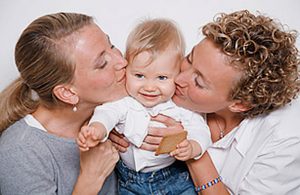A new Australian study that coincides with previous American research from 2005, shows the children of gay parents grow up with normal self-esteem. Melbourne University PhD student Simon Crouch and his team conducted one of the world’s largest studies on gay parents and the well-being of their children. Data was collected from 500 Australian children up to the age of 18 and found that kids growing up in gay and straight families matched equally when it came to self-esteem. In addition, the amount of time the kids spent with their parents as well as their emotional well-being were equally the same.

However, children of same-sex couples scored higher than the national average for overall health and family cohesion. Crouch hypothesized this is because gay parents are more likely to have experienced being teased, and therefore are better able to talk about similar issues with their children. “Because of the situation that same-sex families find themselves in, they are generally more willing to communicate and approach the issues that any child may face at school, like teasing or bullying,” says Crouch.
It’s worth noting that the vast majority of the same-sex parents involved in the study were women — 80 per cent exactly.
“The vast consensus of all the studies shows that children of same-sex parents do as well as children whose parents are heterosexual in every way,” lead researcher and pediatric doctor, Ellen C. Perrin,told WebMD at the time. “In some ways children of same-sex parents actually may have advantages over other family structures.” More here.
 According to an article published by USA Today, unmarried couples who live together are staying together longer than in the past. In addition, more of them are having children, according to the first federal data recently released that details just how cohabitation is transforming families across the United States. The report from the National Center for Health Sciences states that for almost half of the woman ages 15-44, their first “union” was cohabitation rather than marriage. For less than one-quarter, the first union was marriage. The report was based on in-person interviews conducted between 2006 and 2010 with 12,279 women ages 15-44
According to an article published by USA Today, unmarried couples who live together are staying together longer than in the past. In addition, more of them are having children, according to the first federal data recently released that details just how cohabitation is transforming families across the United States. The report from the National Center for Health Sciences states that for almost half of the woman ages 15-44, their first “union” was cohabitation rather than marriage. For less than one-quarter, the first union was marriage. The report was based on in-person interviews conducted between 2006 and 2010 with 12,279 women ages 15-44
Among the findings of the report found on the USA Today website:
- As a first union, 48% of women cohabited with their male partner, up from 43% in 2002 and 34% in 1995.
- 23% of first unions were marriages, down from 30% in 2002 and 39% in 1995. The percentage of women who cohabited as a first union increased for all races and ethnic groups, except Asian women. Among Hispanics, the percentage increased 57%; for whites, 43%; for blacks, 39%.
- 22 months is the median duration of first cohabitation, up from 20 months in 2002 and 13 months in 1995.
- 19% of women became pregnant and gave birth in the first year of a first premarital cohabitation.
- Within three years of cohabiting, 40% of women had transitioned to marriage; 32% remained living together; 27% had broken up.
- 70% of women without a high school diploma cohabited as a first union, compared with 47% of those with a bachelor’s degree or higher.
- Among women ages 22-44 with higher education, their cohabitations were more likely to transition to marriage within years (53%), compared with 30% for those who didn’t graduate high school.
This is an interesting, first of its kind study within the United States and shows that what we once considered to be “normal” with regards to relationships is now evolving, and these new dynamics are having positive results for certain demographics. This just goes to show that many options are out there and one shouldn’t limit themselves to what they were possibly told was the only way.







